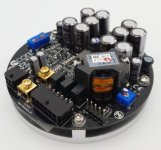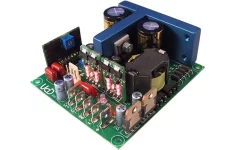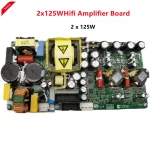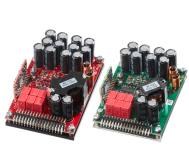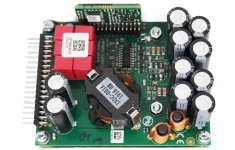The question rises up when a friend was looking for various new power amplifier devices and had serious doubts about the lifetime and reliability of Class-D variants when he saw the modules inside the devices, the images of which I uploaded.
What experience is there here?
Do the electrolytic capacitors have to be replaced early - i.e. after a short period of use?
Or can one assume a similar life expectancy for the well-known brands as for good conventional variants in analog technology (mostly Class AB) ?
At first glance the used electrolytics are in the same kind and same price class as in PC main boards and cheap SMPS modules - go to
https://hackaday.com/2019/04/12/ask-hackaday-experiences-with-capacitor-failure/ (nichicon)
https://de.m.wikipedia.org/wiki/Datei:Al-Elko-bad-caps-Wiki-07-02-17.jpg (GSC)
https://www.robotroom.com/Faulty-Capacitors-1.html (CapXon)
Thanks for comments.
P.S.: Interesting report
https://audioxpress.com/article/fre...-amplifier-module-doubling-down-on-a-flagship
https://www.audiosciencereview.com/forum/index.php?threads/nad-m23.30114/
https://www.audiosciencereview.com/...purifi-eigentakt-is-my-dream-amplifier.25376/
What experience is there here?
Do the electrolytic capacitors have to be replaced early - i.e. after a short period of use?
Or can one assume a similar life expectancy for the well-known brands as for good conventional variants in analog technology (mostly Class AB) ?
At first glance the used electrolytics are in the same kind and same price class as in PC main boards and cheap SMPS modules - go to
https://hackaday.com/2019/04/12/ask-hackaday-experiences-with-capacitor-failure/ (nichicon)
https://de.m.wikipedia.org/wiki/Datei:Al-Elko-bad-caps-Wiki-07-02-17.jpg (GSC)
https://www.robotroom.com/Faulty-Capacitors-1.html (CapXon)
Thanks for comments.
P.S.: Interesting report
https://audioxpress.com/article/fre...-amplifier-module-doubling-down-on-a-flagship
https://www.audiosciencereview.com/forum/index.php?threads/nad-m23.30114/
https://www.audiosciencereview.com/...purifi-eigentakt-is-my-dream-amplifier.25376/
Attachments
Last edited:
While there are forum posts about defective UCD's, there are many of those modules out there, so the reliability of Hypex products seems to be fine.
I see your third image is a clone. I would not trust the reliability of any clone.
Electrolytic capacitors have gotten a bad name due to failures in 1999 - 2007. I think that nowadays, an engineer has enough tools and knowledge to ensure that his product lasts for at least x years. The number x is a choice, depending on what customers would accept, where the product should be placed in the market etc.
I see your third image is a clone. I would not trust the reliability of any clone.
Electrolytic capacitors have gotten a bad name due to failures in 1999 - 2007. I think that nowadays, an engineer has enough tools and knowledge to ensure that his product lasts for at least x years. The number x is a choice, depending on what customers would accept, where the product should be placed in the market etc.
Last edited:
Hypex seems to be less reliable than one would like and I recently read/saw here that they also use plain bad caps now.
Many cheap class D amplifiers are reliable. The impression is that the high(er) power ones fail more offen than than the low power ones. As with about all audio devices the electrolytic caps and PSU is where cost cutting is done.
Contrary to decades ago one does not get any guarantee that (perceived/marketed) A brands are better than lesser known brands.
Many cheap class D amplifiers are reliable. The impression is that the high(er) power ones fail more offen than than the low power ones. As with about all audio devices the electrolytic caps and PSU is where cost cutting is done.
Contrary to decades ago one does not get any guarantee that (perceived/marketed) A brands are better than lesser known brands.
Last edited:
Good circuit engineering is as important as the component quality, specially if you are using not super high quality components.
In AB class amplifier, capacitors were not much stressed as they are in switch mode circuit, so they use to last decades without much attention or component quality.
I personally use an AB amp made in 1979 as many of my friends do - not a single cap replaced.
In switch mode, it's another story. But if you carefully engineer the circuit, by not stressing much the capacitors you can have good reliability.
Main parameters are: ripple current (at specific frequency). temperature and expected life hours.
You can find these parameters in the datasheet and make the correct dimensioning of the capacitors.
Keep capacitors away of other heat sources, keep ripple current low and design for at least 30 years.
Example: if you estimate 2h per day use, you need to design the circuit to have current and temperature under the curve of 2*365*30 = 21.900h
And here's the trick: if you use higher current and higher temperature, so cutting cost, the circuit will work fine, but won't last 30 years, maybe just 10, 5 or 1.
And will depend on how much power the user will demand and at which ambient temperature the amp will be used.
Switch mode is a different world from AB class, where we normally didn't think about amp "wearing out".
In switching mode, it depends on how the design was made.
Just an example of what I'm talking about.
You take the IAC (ripple current) you plan to use and make the ratio with the IAC, R taken from the table for the specific cap value.
Then you go to the curve and select how many life hours you plan to have.
Here the designer makes the choice on how long the circuit will last.


In AB class amplifier, capacitors were not much stressed as they are in switch mode circuit, so they use to last decades without much attention or component quality.
I personally use an AB amp made in 1979 as many of my friends do - not a single cap replaced.
In switch mode, it's another story. But if you carefully engineer the circuit, by not stressing much the capacitors you can have good reliability.
Main parameters are: ripple current (at specific frequency). temperature and expected life hours.
You can find these parameters in the datasheet and make the correct dimensioning of the capacitors.
Keep capacitors away of other heat sources, keep ripple current low and design for at least 30 years.
Example: if you estimate 2h per day use, you need to design the circuit to have current and temperature under the curve of 2*365*30 = 21.900h
And here's the trick: if you use higher current and higher temperature, so cutting cost, the circuit will work fine, but won't last 30 years, maybe just 10, 5 or 1.
And will depend on how much power the user will demand and at which ambient temperature the amp will be used.
Switch mode is a different world from AB class, where we normally didn't think about amp "wearing out".
In switching mode, it depends on how the design was made.
Just an example of what I'm talking about.
You take the IAC (ripple current) you plan to use and make the ratio with the IAC, R taken from the table for the specific cap value.
Then you go to the curve and select how many life hours you plan to have.
Here the designer makes the choice on how long the circuit will last.
Last edited:
There might be the case. As I mentioned, if you exceed these numbers, the circuit works fine for quite some time and maybe enough to pass the warranty time, specially in consumer equipments, where, in general, you don't use it 24h/day at maximum power.
It's a distinct case of exceeding, for example, transistor Vce maximum voltage.
Depending on how much you exceed, it blows up instantly so the designer will not take the decision of exceeding this specific limit.
It's a distinct case of exceeding, for example, transistor Vce maximum voltage.
Depending on how much you exceed, it blows up instantly so the designer will not take the decision of exceeding this specific limit.
